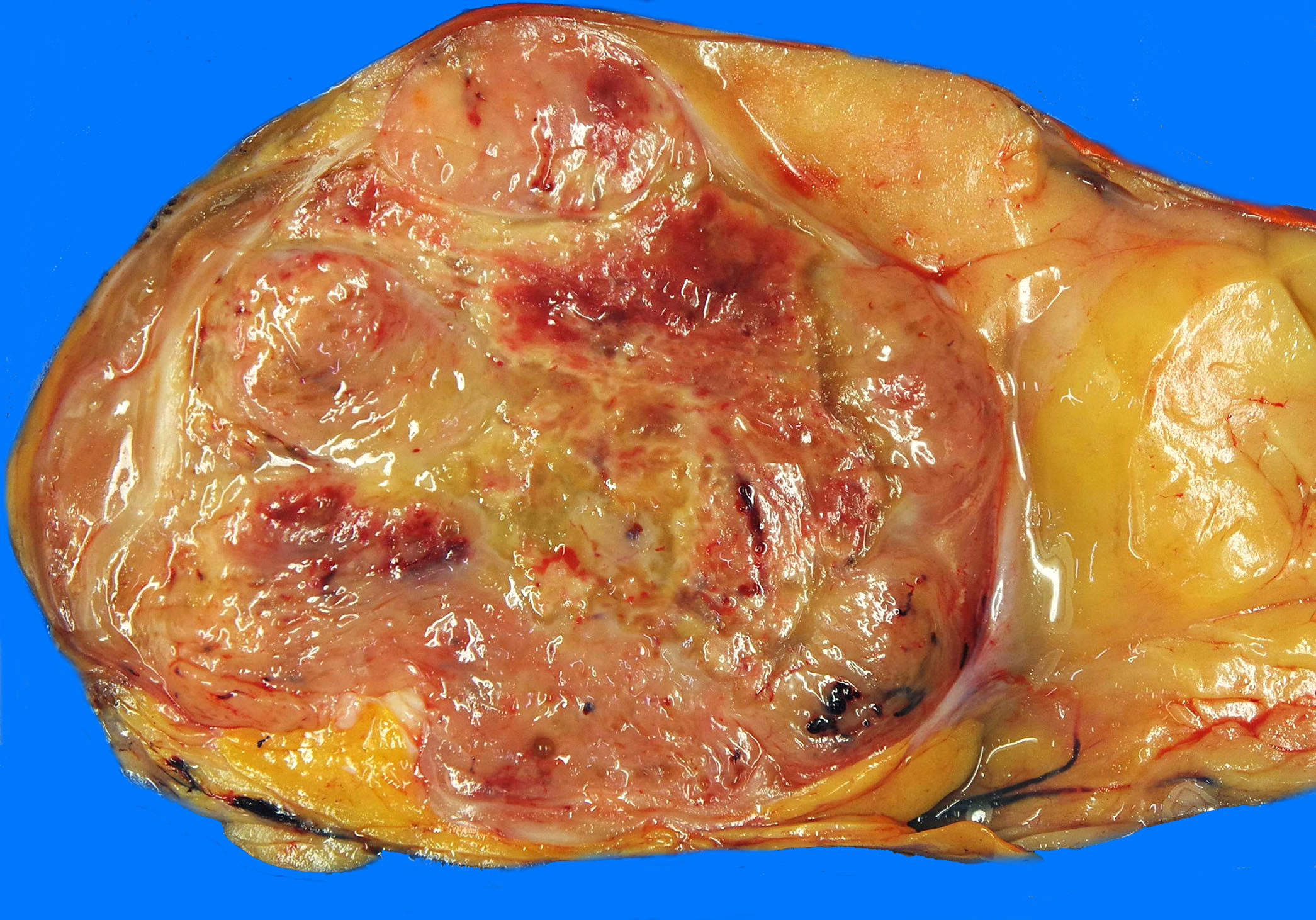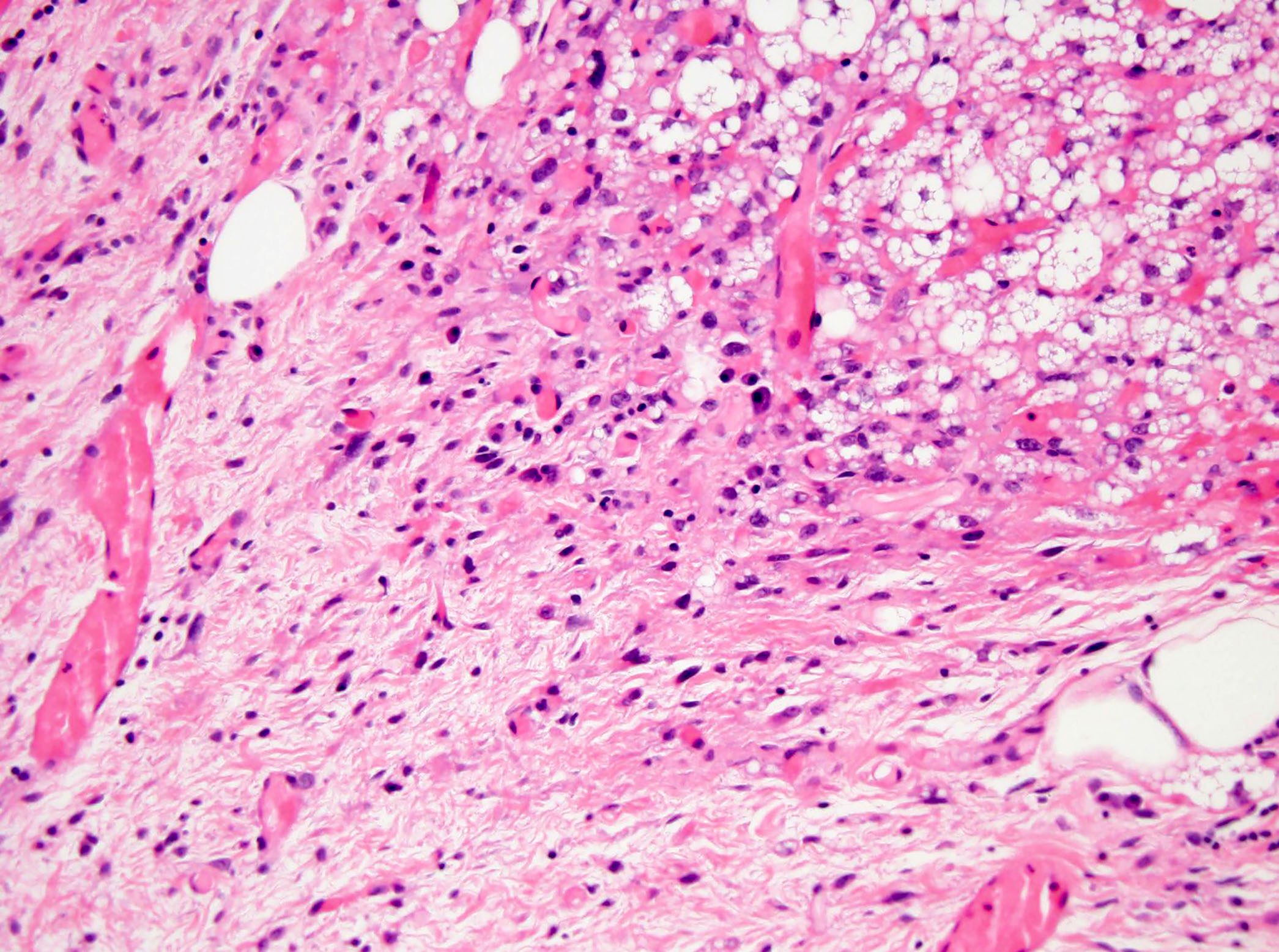Soft tissue
General
Staging
Last author update: 24 August 2023
Last staff update: 24 August 2023
Copyright: 2002-2024, PathologyOutlines.com, Inc.
PubMed Search:
Soft tissue staging
Page views in 2023: 2,968
Page views in 2024 to date: 1,159
Cite this page: Alexiev BA. Staging. PathologyOutlines.com website. https://www.pathologyoutlines.com/topic/softtissuestaging.html. Accessed April 18th, 2024.
Definition / general
- Includes soft tissue tumors of intermediate (locally aggressive and rarely metastasizing) potential and malignant soft tissue tumors
- Does not include carcinosarcoma, pediatric Ewing sarcoma, pediatric rhabdomyosarcoma, Kaposi sarcoma, gastroinstestinal stromal tumor and uterine sarcoma
Essential features
- AJCC 7th edition staging was sunset on December 31, 2017; as of January 1, 2018; use of the 8th edition is mandatory
- TNM staging system for soft tissue tumors applies to all soft tissue sarcomas of the extremities and trunk, abdomen, thoracic visceral organs and retroperitoneum except Kaposi sarcoma, gastrointestinal stromal tumors, fibromatosis (desmoid tumor) and infantile fibrosarcoma
- Staging system applies to all soft tissue sarcomas of the head and neck except angiosarcoma, rhabdomyosarcoma of the embryonal and alveolar subtypes, Kaposi sarcoma and dermatofibrosarcoma protuberans
- Sarcomas arising within the confines of the dura mater, including the brain, are not optimally staged by this system
- Regardless of the anatomic site, locally aggressive soft tissue neoplasms, which may recur locally but have either no risk of metastatic disease or an extremely low risk of metastasis, are excluded from the AJCC soft tissue sarcoma staging system
- Note: see CAP for additional information
Terminology
- Reporting of pT (tumor), pN (lymph node) and (when applicable) pM (metastasis) categories is based on information available to the pathologist at the time the report is issued; as per the AJCC, it is the managing physician's responsibility to establish the final pathologic stage based upon all pertinent information (Amin: AJCC Cancer Staging Manual, 8th Edition, 2018)
- Tumor (T):
- Based on the tumor size, as measured grossly or with imaging
- Largest dimension in any plane
- Best to provide 3 dimensional size if possible
- Nodes (N):
- Lymph node status needs to be determined both clinically and microscopically
- Metastasis (M):
- Either not applicable (pM cannot be determined from the submitted specimen[s]) or distant metastasis (pM1)
- Prefix:
- If the lesion was previously treated, use the prefix y (ypTNM)
- If the lesion is recurrent, use the prefix r (rpTNM)
Primary tumor (pT)
- Head and neck
- pT: not assigned (cannot be determined based on available pathological information)
- pT1: tumor ≤ 2 cm
- pT2: tumor > 2 cm to ≤ 4 cm
- pT3: tumor > 4 cm
- pT4: tumor with invasion of adjoining structures
- pT4a: tumor with orbital invasion, skull base / dural invasion, invasion of central compartment viscera, involvement of facial skeleton or invasion of pterygoid muscles
- pT4b: tumor with brain parenchymal invasion, carotid artery encasement, prevertebral muscle invasion or central nervous system involvement via perineural spread
- pT4 (subcategory cannot be determined)
- Trunk and extremities
- pT: not assigned (cannot be determined based on available pathological information)
- pT0: no evidence of primary tumor
- pT1: tumor ≤ 5 cm in greatest dimension
- pT2: tumor > 5 cm and ≤ 10 cm in greatest dimension
- pT3: tumor > 10 cm and ≤ 15 cm in greatest dimension
- pT4: tumor > 15 cm in greatest dimension
- Abdomen and thoracic visceral organs
- pT: not assigned (cannot be determined based on available pathological information)
- pT1: organ confined
- pT2: tumor extension into tissue beyond organ
- pT2a: invades serosa or visceral peritoneum
- pT2b: extension beyond serosa (mesentery)
- pT2 (subcategory cannot be determined)
- pT3: invades another organ
- pT4: multifocal involvement
- pT4a: multifocal (2 sites)
- pT4b: multifocal (3 - 5 sites)
- pT4c: multifocal (> 5 sites)
- pT4 (subcategory cannot be determined)
- Retroperitoneum
- pT: not assigned (cannot be determined based on available pathological information)
- pT0: no evidence of primary tumor
- pT1: tumor ≤ 5 cm in greatest dimension
- pT2: tumor > 5 cm and ≤ 10 cm in greatest dimension
- pT3: tumor > 10 cm and ≤ 15 cm in greatest dimension
- pT4: tumor > 15 cm in greatest dimension
- Orbit
- pN: not assigned (no nodes submitted or found)
- pT: not assigned (cannot be determined based on available pathological information)
- pT0: no evidence of primary tumor
- pT1: tumor ≤ 2 cm in greatest dimension
- pT2: tumor > 2 cm in greatest dimension without invasion of bony walls or globe
- pT3: tumor of any size with invasion of bony walls
- pT4: tumor of any size with invasion of globe or periorbital structures, including eyelid, conjunctiva, temporal fossa, nasal cavity, paranasal sinuses or central nervous system
Regional lymph nodes (pN)
- pN: not assigned (no nodes submitted or found)
- pN: not assigned (cannot be determined based on available pathological information)
- pN0: no regional lymph node metastasis
- pN1: regional lymph node metastasis
Prefixes
- Not applicable
- m: multiple
- y: preoperative radiotherapy or chemotherapy
- r: recurrent tumor stage
Histologic grade (G)
- 8th edition of the AJCC Cancer Staging Manual adopted the French Federation of Cancer Centers Sarcoma Group (FNCLCC) grading system (Amin: AJCC Cancer Staging Manual, 8th Edition, 2018)
- FNCLCC grading
- FNCLCC grade is based on 3 parameters: differentiation, mitotic activity and necrosis
- Each of these parameters receives a score: differentiation (1 to 3), mitotic activity (1 to 3) and necrosis (0 to 2); the scores are summed to produce a grade (Arch Pathol Lab Med 2006;130:1448)
- GX: cannot be assessed
- G1: 2 or 3
- G2: 4 or 5
- G3: 6 to 8
- Differentiation: tumor differentiation is scored as follows
- Score 1: sarcomas closely resembling normal, adult mesenchymal tissue and potentially difficult to distinguish from the counterpart benign tumor (e.g., well differentiated liposarcoma, well differentiated leiomyosarcoma)
- Score 2: sarcomas for which histologic typing is certain (e.g., myxoid liposarcoma, myxofibrosarcoma)
- Score 3: embryonal sarcomas and undifferentiated sarcomas, synovial sarcomas and sarcomas of doubtful tumor type
Table 1: Tumor differentiation
| Histologic type |
Score |
| Atypical lipomatous tumor / well differentiated liposarcoma
| 1
|
| Well differentiated leiomyosarcoma
| 1
|
| Malignant neurofibroma
| 1
|
| Well differentiated fibrosarcoma
| 1
|
| Myxoid liposarcoma
| 2
|
| Conventional leiomyosarcoma
| 2
|
| Conventional fibrosarcoma
| 2
|
| Myxofibrosarcoma
| 2
|
| High grade myxoid (round cell) liposarcoma
| 3
|
| Pleomorphic liposarcoma
| 3
|
| Dedifferentiated liposarcoma
| 3
|
| Pleomorphic rhabdomyosarcoma
| 3
|
| Poorly differentiated / pleomorphic leiomyosarcoma
| 3
|
| Biphasic / monophasic / poorly differentiated synovial sarcoma
| 3
|
| Mesenchymal chondrosarcoma
| 3
|
| Extraskeletal osteosarcoma
| 3
|
| Extraskeletal Ewing sarcoma
| 3
|
| Malignant rhabdoid tumor
| 3
|
| Undifferentiated pleomorphic sarcoma
| 3
|
| Undifferentiated sarcoma, not otherwise specified
| 3
|
Notes:
- Grading of malignant peripheral nerve sheath tumor, embryonal and alveolar rhabdomyosarcoma, angiosarcoma, extraskeletal myxoid chondrosarcoma, alveolar soft part sarcoma, clear cell sarcoma and epithelioid sarcoma is not recommended (Cancer 1984;53:530)
- Case for grading malignant peripheral nerve sheath tumor is currently being debated
- Mitosis count: the count is made in the most mitotically active area, away from areas of necrosis, in either 10 consecutive high power fields (HPF) (use the 40x objective) (1 HPF x 400 = 0.1734 mm2) or in the appropriate number of HPF to encompass 1 mm2 based on each individual microscope; if the mitotic rate is close to the cutoff between mitotic scores, the count should be repeated
Table 2: Mitotic count score equivalent
| Mitotic score
| # mitosis/10 HPF
| # mitosis/1 mm2
|
| Score 1
| 0 - 9 mitosis/10 HPF
| 0 - 5 mitosis/1 mm2
|
| Score 2
| 10 - 19 mitosis/10 HPF
| 6 - 11 mitosis/1 mm2
|
| Score 3
| > 19 mitosis/10 HPF
| > 11 mitosis/1 mm2
|
- Tumor necrosis: evaluated on gross examination and validated with histologic sections
Table 3: Necrosis
| Score
| Necrosis
|
| Score 0
| No tumor necrosis
|
| Score 1
| < 50% tumor necrosis
|
| Score 2
| ≥ 50% tumor necrosis
|
Histopathologic type (2020 WHO classification of soft tissue tumors)
- Adipocytic tumors
- Intermediate (locally aggressive)
- Atypical lipomatous tumor
- Malignant
- Well differentiated liposarcoma
- Dedifferentiated liposarcoma
- Myxoid liposarcoma
- Pleomorphic liposarcoma
- Epithelioid liposarcoma
- Myxoid pleomorphic liposarcoma
- Fibroblastic / myofibroblastic tumors
- Intermediate (rarely metastasizing)
- Fibrosarcomatous dermatofibrosarcoma protuberans
- Malignant
- Solitary fibrous tumor, malignant
- Adult fibrosarcoma
- Myxofibrosarcoma
- Epithelioid myxofibrosarcoma
- Low grade fibromyxoid sarcoma
- Sclerosing epithelioid fibrosarcoma
- So called fibrohistiocytic tumors
- Malignant
- Malignant tenosynovial giant cell tumor
- Smooth muscle tumors
- Pericytic (perivascular) tumors
- Skeletal muscle tumors
- Malignant
- Embryonal rhabdomyosarcoma (including botryoid, anaplastic)
- Alveolar rhabdomyosarcoma (including solid, anaplastic)
- Pleomorphic rhabdomyosarcoma
- Spindle cell / sclerosing rhabdomyosarcoma
- Spindle cell / sclerosing rhabdomyosarcoma, NOS
- Congenital spindle cell rhabdomyosarcoma with VGLL2 / NCOA2 / CITED2 rearrangements
- MYOD1 mutant spindle cell / sclerosing rhabdomyosarcoma
- Intraosseous spindle cell rhabdomyosarcoma (with TFCP2 / NCOA2 rearrangements)
- Ectomesenchymoma
- Vascular tumors
- Malignant
- Epithelioid hemangioendothelioma with WWTR1::CAMTA1 fusion
- Epithelioid hemangioendothelioma with YAP1::TFE3 fusion
- Epithelioid hemangioendothelioma, NOS
- Peripheral nerve tumors
- Malignant
- Malignant peripheral nerve sheath tumor
- Epithelioid malignant peripheral nerve sheath tumor
- Malignant granular cell tumor
- Malignant perineurioma
- Chondro-osseous tumors
- Malignant
- Extraskeletal osteosarcoma
- Tumors of uncertain differentiation
- Intermediate (rarely metastasizing)
- Ossifying fibromyxoid tumor
- Mixed tumor
- Mixed tumor, NOS, malignant
- Myoepithelioma
- Malignant
- Phosphaturic mesenchymal tumor, malignant
- NTRK rearranged spindle cell neoplasm
- Synovial sarcoma, biphasic
- Synovial sarcoma, spindle cell
- Synovial sarcoma, poorly differentiated
- Synovial sarcoma, NOS
- Epithelioid sarcoma, classic type
- Epithelioid sarcoma, proximal or large cell type
- Alveolar soft part sarcoma
- Clear cell sarcoma of soft tissue
- Extraskeletal myxoid chondrosarcoma
- Ossifying fibromyxoid tumor, malignant
- Myoepithelial carcinoma
- Extraskeletal Ewing sarcoma
- Round cell sarcoma with EWSR1 non-ETS fusions
- CIC rearranged sarcoma
- Undifferentiated / unclassified sarcomas
- Malignant
- Undifferentiated spindle cell sarcoma
- Undifferentiated pleomorphic sarcoma
- Undifferentiated round cell sarcoma
- Undifferentiated sarcoma, NOS
Gross images
Contributed by Borislav A. Alexiev, M.D.

Leiomyosarcoma of soft tissue

Dedifferentiated liposarcoma
Microscopic (histologic) images
Contributed by Borislav A. Alexiev, M.D.

Leiomyosarcoma of soft tissue

Atypical
lipomatous tumor /
well differentiated
liposarcoma
Board review style question #1
Which of the following tumor types should be reported / staged using the Protocol for Examination of Resection Specimens from Patients with Soft Tissue Tumors (pTNM, AJCC 8th edition)?
- Carcinosarcoma
- Extraskeletal myxoid chondrosarcoma
- Gastrointestinal stromal tumor
- Kaposi sarcoma
- Uterine sarcoma
Board review style answer #1
B. Extraskeletal myxoid chondrosarcoma. Answers A, C, D and E are incorrect because the following tumor types should not be reported using this protocol: carcinosarcoma (consider the appropriate site specific carcinoma protocol), gastrointestinal stromal tumor (consider the gastrointestinal stromal tumor protocol), Kaposi sarcoma and uterine sarcoma (consider the uterine sarcoma protocol).
Comment Here
Reference:
Soft tissue - Staging
Board review style question #2
Which is the correct pT for a retroperitoneal dedifferentiated liposarcoma that is 12 cm?
- pT0
- pT1
- pT2
- pT3
- pT4
Board review style answer #2
D. pT3. pT3 is defined as a retroperitoneal tumor that is > 10 cm and ≤ 15 cm in greatest dimension. Answer A is incorrect because pT0 means no evidence of primary tumor. Answer B is incorrect because pT1 is a tumor ≤ 5 cm in greatest dimension. Answer C is incorrect because pT2 is a tumor > 5 cm and ≤ 10 cm in greatest dimension. Answer E is incorrect because pT4 is a tumor > 15 cm in greatest dimension.
Comment Here
Reference:
Soft tissue - Staging
Back to top







